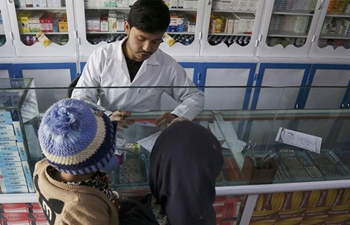GENEVA, Nov. 27 (Xinhua) -- The World Health Organization (WHO) issued new recommendations on Wednesday to help countries reach the 8.1 million people living with HIV who are yet to be diagnosed, and who are therefore unable to obtain lifesaving treatment.
The new recommendations include a range of innovative approaches to respond to contemporary needs. For example, the WHO encourages all countries to adopt a standard HIV testing strategy which uses three consecutive reactive tests to provide an HIV positive diagnosis. Previously, most high burden countries were using two consecutive tests. The new approach can help countries achieve maximum accuracy in HIV testing.
HIV self-testing is highly recommended as a gateway to diagnosis for those who are at higher HIV risk but not testing in clinical settings, while social network-based HIV testing can be used to reach key populations, such as men who have sex with men, people who inject drugs, sex workers, transgender population and people in prisons. Those key populations account for over 50 percent of new HIV infections but have less access to services, the WHO said.
It also recommends innovative digital communications, such as short messages and videos, as a means to increase uptake of HIV testing, and focused community efforts to deliver rapid testing where longstanding lab-based method called "western blotting" is still in use.
For mother-to-child HIV transmission, the WHO recommends using HIV/syphilis dual rapid tests in antenatal care, as the first HIV test can help countries eliminate mother-to-child transmission of both infections.
"Saving lives from HIV starts with testing. These new recommendations can help countries to accelerate their progress and respond more effectively to the changing nature of their HIV epidemics," said Rachel Baggaley, WHO's Team lead for HIV Testing, Prevention and Populations.
According to WHO statistics, there were 36.7 million people with HIV worldwide at the end of 2018, of which 79 percent had been diagnosed, 62 percent on treatment, and 53 percent had reduced their HIV levels through sustained treatment, substantially reducing the risk of transmitting HIV.

















